
Main Injector Experiment for ν-A, or MINERνA, is a neutrino scattering experiment which uses the NuMI beamline at Fermilab. MINERνA seeks to measure low energy neutrino interactions both in support of neutrino oscillation experiments and also to study the strong dynamics of the nucleon and nucleus that affect these interactions.
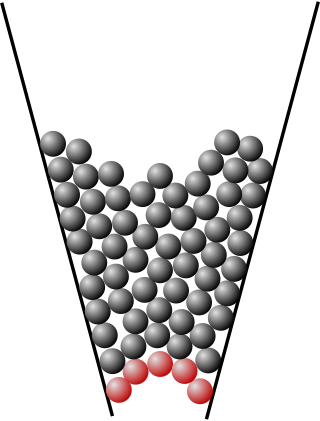
Jamming is the physical process by which the viscosity of some mesoscopic materials, such as granular materials, glasses, foams, polymers, emulsions, and other complex fluids, increases with increasing particle density. The jamming transition has been proposed as a new type of phase transition, with similarities to a glass transition but very different from the formation of crystalline solids.
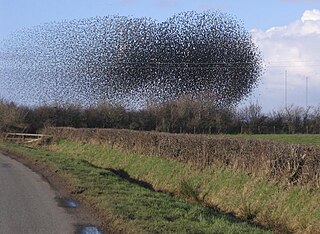
Active matter is matter composed of large numbers of active "agents", each of which consumes energy in order to move or to exert mechanical forces. Such systems are intrinsically out of thermal equilibrium. Unlike thermal systems relaxing towards equilibrium and systems with boundary conditions imposing steady currents, active matter systems break time reversal symmetry because energy is being continually dissipated by the individual constituents. Most examples of active matter are biological in origin and span all the scales of the living, from bacteria and self-organising bio-polymers such as microtubules and actin, to schools of fish and flocks of birds. However, a great deal of current experimental work is devoted to synthetic systems such as artificial self-propelled particles. Active matter is a relatively new material classification in soft matter: the most extensively studied model, the Vicsek model, dates from 1995.
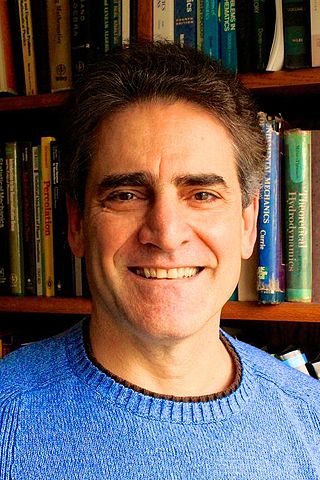
Salvatore Torquato is an American theoretical scientist born in Falerna, Italy. His research work has impacted a variety of fields, including physics, chemistry, applied and pure mathematics, materials science, engineering, and biological physics. He is the Lewis Bernard Professor of Natural Sciences in the department of chemistry and Princeton Institute for the Science and Technology of Materials at Princeton University. He has been a senior faculty fellow in the Princeton Center for Theoretical Science, an enterprise dedicated to exploring frontiers across the theoretical natural sciences. He is also an associated faculty member in three departments or programs at Princeton University: physics, applied and computational mathematics, and mechanical and aerospace engineering. On multiple occasions, he was a member of the schools of mathematics and natural sciences at the Institute for Advanced Study, Princeton, New Jersey.
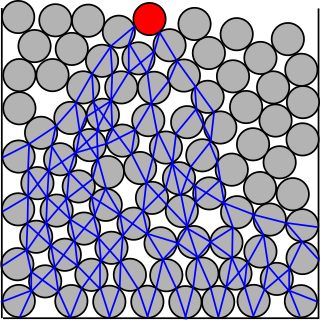
In the study of the physics of granular materials, a force chain consists of a set of particles within a compressed granular material that are held together and jammed into place by a network of mutual compressive forces.
Rigidity theory, or topological constraint theory, is a tool for predicting properties of complex networks based on their composition. It was introduced by James Charles Phillips in 1979 and 1981, and refined by Michael Thorpe in 1983. Inspired by the study of the stability of mechanical trusses as pioneered by James Clerk Maxwell, and by the seminal work on glass structure done by William Houlder Zachariasen, this theory reduces complex molecular networks to nodes constrained by rods, thus filtering out microscopic details that ultimately don't affect macroscopic properties. An equivalent theory was developed by P.K. Gupta A.R. Cooper in 1990, where rather than nodes representing atoms, they represented unit polytopes. An example of this would be the SiO tetrahedra in pure glassy silica. This style of analysis has applications in biology and chemistry, such as understanding adaptability in protein-protein interaction networks. Rigidity theory applied to the molecular networks arising from phenotypical expression of certain diseases may provide insights regarding their structure and function.
Hyperuniform materials are characterized by an anomalous suppression of density fluctuations at large scales. More precisely, the vanishing of density fluctuations in the long-wave length limit distinguishes hyperuniform systems from typical gases, liquids, or amorphous solids. Examples of hyperuniformity include all perfect crystals, perfect quasicrystals, and exotic amorphous states of matter.
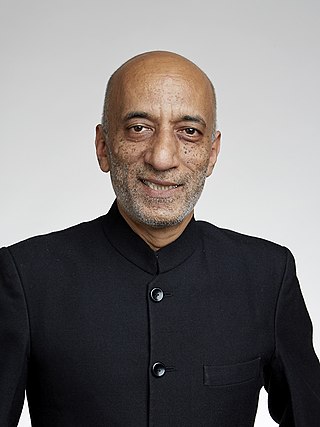
Sriram Rajagopal Ramaswamy is an Indian physicist. He is a professor at the Indian Institute of Science, Bangalore, and previously the director of the Tata Institute of Fundamental Research (TIFR) Centre for Interdisciplinary Sciences in Hyderabad.
Kathryn M. Zurek is an American physicist and professor of theoretical physics at the California Institute of Technology. Her research interests primarily lie at the intersection of particle physics with cosmology and particle astrophysics. She is known for her theories on dark matter's "hidden valleys", also known as hidden sectors.

Fiber network mechanics is a subject within physics and mechanics that deals with the deformation of networks made by the connection of slender fibers,. Fiber networks are used to model the mechanics of fibrous materials such as biopolymer networks and paper products. Depending on the mechanical behavior of individual filaments, the networks may be composed of mechanical elements such as Hookean springs, Euler-Bernoulli beams, and worm-like chains. The field of fiber network mechanics is closely related to the mechanical analysis of frame structures, granular materials, critical phenomena, and lattice dynamics.

Kerstin N. Nordstrom is an American physicist who is the Clare Boothe Luce Assistant Professor of Physics in the Department of Physics at Mount Holyoke College. Her research focuses on soft matter physics; her work has been featured in the LA Times and in the BBC News.

Maria Cristina Marchetti is an Italian-born, American theoretical physicist specializing in statistical physics and condensed matter physics. In 2019, she received the Leo P. Kadanoff Prize of the American Physical Society. She held the William R. Kenan, Jr. Distinguished Professorship of Physics at Syracuse University, where she was the director of the Soft and Living Matter program, and chaired the department 2007–2010. She is currently Professor of Physics at the University of California, Santa Barbara.

Antonio Helio de Castro Neto is a Brazilian-born physicist. He is the founder and director of the Centre for Advanced 2D Materials at the National University of Singapore. He is a condensed matter theorist known for his work in the theory of metals, magnets, superconductors, graphene and two-dimensional materials. He is a distinguished professor in the Departments of Materials Science Engineering, and Physics and a professor at the Department of Electrical and Computer Engineering. He was elected as a fellow of the American Physical Society in 2003. In 2011 he was elected as a fellow of the American Association for the Advancement of Science.
John F. Mitchell is an American chemist and researcher. He is the deputy director of the materials science division at the U.S. Department of Energy's (DOE) Argonne National Laboratory and leads Argonne's Emerging Materials Group.
Alessio Zaccone is an Italian physicist.
Douglas J. Durian is Professor of Physics and Astronomy at the University of Pennsylvania. He is known for his research contributions to the field of experimental soft matter, particularly in the areas of foams and granular flows. He has held multiple visiting professorships and leaderships positions in the soft matter physics community. He is a Fellow of the American Physical Society.

Jean-Philippe Ansermet is a Swiss physicist and engineer and a professor at École Polytechnique Fédérale de Lausanne. His research focuses on the fabrication and properties of nanostructured materials as well as spintronics.
Straintronics is the study of how folds and mechanically induced stresses in a layer of two-dimensional materials can change their electrical properties. It is distinct from twistronics in that the latter involves changes in the angle between two layers of 2D material. However, in such multi-layers if strain is applied to only one layers, which is called heterostrain, strain can have similar effect as twist in changing electronic properties. It is also distinct from, but similar to, the piezoelectric effects which are created by bending, twisting, or squeezing of certain material.
In statistical mechanics and condensed matter physics, the Kovacs effect is a kind of memory effect in glassy systems below the glass-transition temperature. A.J. Kovacs observed that a system’s state out of equilibrium is defined not only by its macro thermodynamical variables, but also by the inner parameters of the system. In the original effect, in response to a temperature change, under constant pressure, the isobaric volume and free energy of the system experienced a recovery characterized by non-monotonic departure from equilibrium, whereas all other thermodynamical variables were in their equilibrium values. It is considered a memory effect since the relaxation dynamics of the system depend on its thermal and mechanical history.
Dov I. Levine is an American-Israeli physicist, known for his research on quasicrystals, soft condensed matter physics, and statistical mechanics out of equilibrium.










